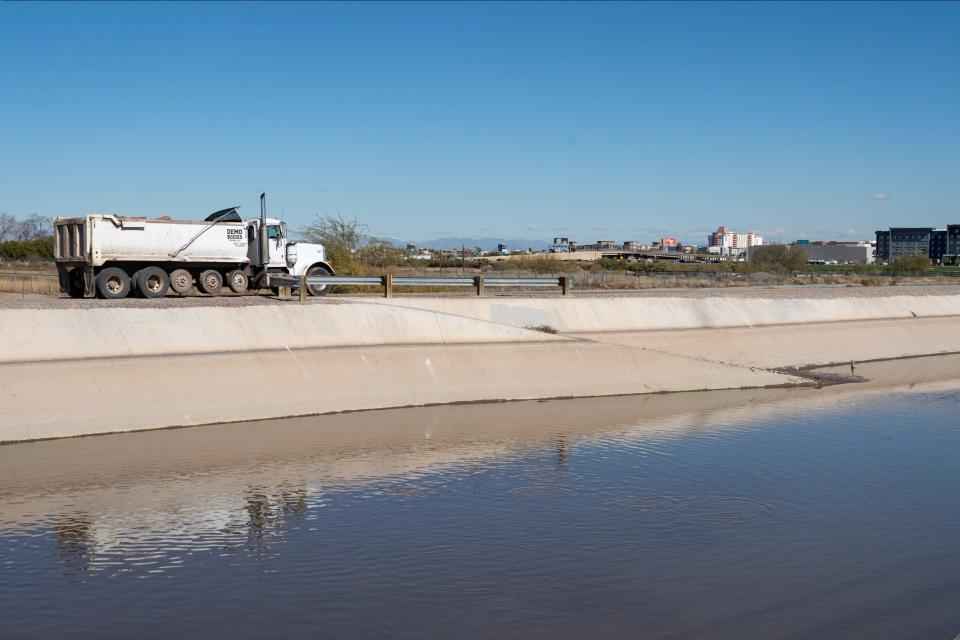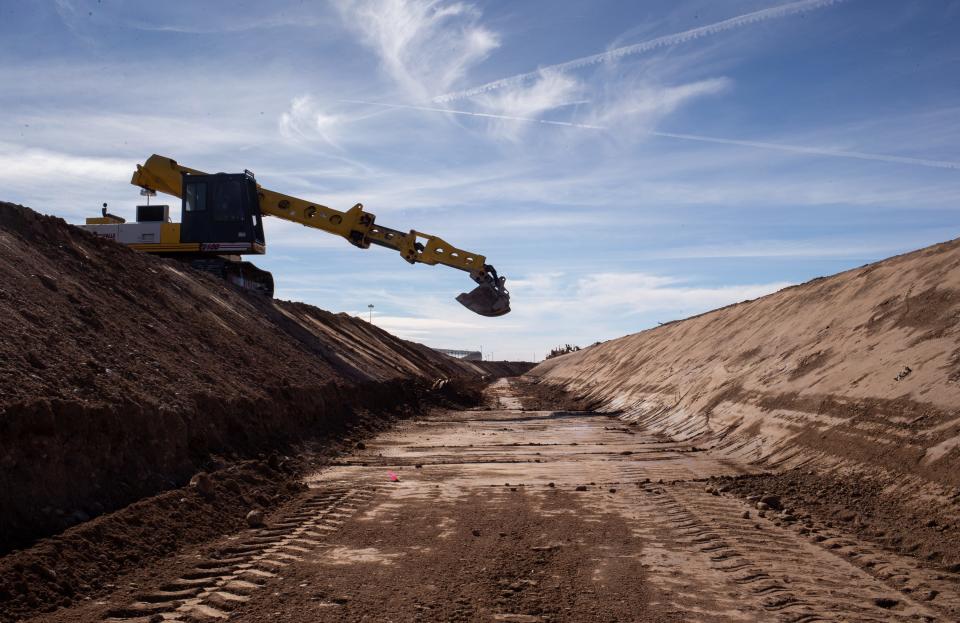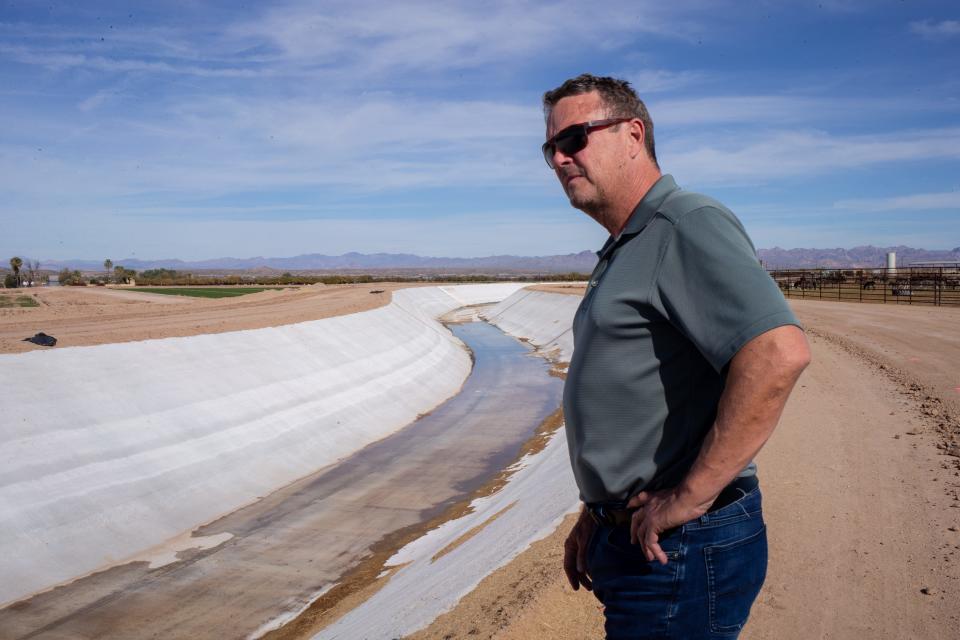$10M in grants will help metro Phoenix communities conserve water. Here's how
Irrigation districts in central Arizona are upgrading their delivery systems, improvements they say will result in big water savings.
Miles of earthen canals in Pinal and Maricopa counties will be lined with concrete, centuries-old flood control gates replaced, and parts of the systems automated to increase efficiency and reduce water loss.
Irrigation districts have long carried out some of these system repairs, but $9.8 million awarded from the Water Infrastructure Finance Authority's Water Conservation Grant Fund will give the revamps an extra push.
The independent state authority approved seven water conservation grants for the Buckeye Water Conservation and Drainage District, Roosevelt Irrigation District and the San Carlos Irrigation and Drainage District. The projects must be completed by 2026, and many are already underway.
Upgrading the aging infrastructure is costly, but badly needed, district managers said. Canals in need of repair can lose over 30% of the water they transport to seepage, and old control gates and spillways fail to recover and divert water in years of plenty.
Securing additional surface water for irrigation will reduce groundwater pumping, they said.
Applicants said the projects could save massive amounts of water, from 3,109 acre-feet a year to 24,974 acre-feet.
The water savings won’t translate to increased water allocation to their customers, all district representatives told The Arizona Republic.
Legislature acts: Pipelines? Desalination? Turf removal? Arizona commits $1B to augment, conserve water supplies
Claiming water the years of plenty
The Roosevelt Irrigation District, or RID, got three out of five submitted projects approved.
The first will help repair and line 7.5 miles of the main canal and some small lateral sections. A second project will add controls and monitors to automate the system.
Accounting for the water entering and leaving the system will make it more efficient, said Taylor Howerter, the district's assistant superintendent.
Since the early 1990s, the district has received treated effluent from Phoenix in exchange for leaving water in the aquifer.
"Currently there's ebbs and flows in the water we receive from the Phoenix wastewater treatment plant. When those highs and lows come in, they're hard to manage," Howerter said. "If I have the automation system set up, I can see that water comes through the system and I can use it to better effect."
This would avoid overflows or sending too much water in one direction because of the pressure of big flows, he added. It also makes deliveries to customers more reliable and consistent.
A third project will allow the district to harness so-called spill water deliveries from Salt River Project.

An excess of water can flow through Arizona’s creeks and rivers when the snowpack in high mountain ranges starts to melt. That excess water can either make its way down to the Gila River or be captured, partially, by mid-system water users.
A new gate and delivery pipeline next to SRP facilities in Glendale will allow the district to take as much as 2,500 acre-feet of water spills from the Salt and Verde rivers.
RID is “almost exclusively a groundwater district,” Howerter said. It has 110 wells and provides water and energy services to residential and municipal customers, as well as about 400 agricultural producers.
Making the best use of other water sources, whether effluent or spill deliveries, helps preserve the aquifer.
“If we can capture as much of that as we can, that's more time with my pumps off.”
Stretching supplies: How did a state board spend $100 million in water conservation grant money?
Overdue canal rehabilitation
Another irrigation district will use the money to replace a 120-year-old floodgate, among other things.
The San Carlos Irrigation and Drainage District, which serves about 250 farmers in Pinal County, has some of the oldest canals in central Arizona. Most of the system was built in 1880. Until 2017, its whole system was made of earthen canals.
Seepage is significant. Water must meander some 60 miles from Coolidge Dam to the Ashurst-Hayden Gila River Diversion outside of Florence, and then to Casa Grande.

That distance will not change. But concrete-lined canals can allow the district to pool water, reduce losses, and increase efficiency, said General Manager Brandi Ogle.
The district has already lined almost 15 miles of a total of 60 miles of the main canal with concrete and will begin with another 12-mile stretch soon.
WIFA grant money will pay for work to demolish and replace century-old gates in the top and bottom of the system. A $555,658 grant will help replace a gate installed in 1904 with a modern automated system to divert water.
“It will allow us to better control the water that we need to spill, versus the water that needs to continue traveling down the system,” Ogle said.
"We will be able to do it much faster than standing out there with a hand crank and going hundreds of rotations at a time to get the gates to open and close."
A separate grant will help pay to replace another century-old gate that is used to flush accumulated sediment from the diversion dam.
The canal check structure, Little Mountain Spillway, is made of wooden weir boards. That means every time there is a big storm or a lot of water coming down the system, operators have to manually install the boards, which creates "excessive spills and places the canal system at risk of failure due to overtopping," the application said.
The WIFA grant will help replace the gate and install a pipe "to preserve spills and put them to beneficial use."

The district is also applying for a different grant to create a mid-system reservoir, Ogle said, so when users in Casa Grande call for water, it would be released from that reservoir versus all the way from Coolidge Dam.
Tribal project: 'Blue-green economy': Work to start on installing solar panels over Gila River canals
Solar canals and expanded reservoirs
WIFA also awarded two grants to the Buckeye Water Conservation and Drainage District to help modernize its main canal.
The district relies on treated effluent from Phoenix and surface water from the Salt, Verde, Gila, and Agua Fria rivers, with about 40% of its supply coming from wells. It provides water to irrigate about 22,000 acres of farmland.
Mid-system and end-of-system reservoirs would help make more efficient use of surface water, said district manager Noel Carter.
The district is already building a 400-acre reservoir at the higher end of the canal to store water in the winter, when the demand is low, and use it in high-demand periods like summer.
With the state grant money, the district will rebuild the gates and retention structure at the end of its canal to pool more water. A 4-acre reservoir, with an automated system, will replace the small retention pond, reduce spills and provide "on-demand irrigation service to the 1,500 acres downstream," the application said.
Carter estimates that every year the district lets go of some 20,000 acre-feet of water. The project will reduce that amount by half.
The additional surface water won’t translate into higher water allocations, Carter said.
Another portion of the state grants will go to rebuild and automate the structure that diverts water into the canals and replace an old gate that flushes sediment out of the system. It will also pay to cover 600 feet of the canal with solar panels and install a hydro-turbine to produce renewable energy.
The upgrades are expected to reduce groundwater pumping and conserve over 32,000 acre-feet of water a year, according to the district’s application.
Urban agriculture: Support for locally grown food is high. Here's why land in Phoenix is scarce for the growers
Tracking project results could drive policy
The irrigation districts are three of dozens of grantees that last year received funds from WIFA for water conservation.
Awarded projects were diverse, spanning water-use sectors, which was the intent of the state authority.
Agricultural system upgrades, a category that united 33 awarded grants, brought the biggest bang for the buck, according to the information provided by applicants to WIFA.
For every dollar spent, these projects claimed they could save anywhere between 700 and 66,000 gallons. That was the greatest return on investment by far of all projects submitted.
But so far there is no robust system in place to see how much water the projects end up saving.
WIFA asked applicants how they would measure the results of their work and included some reporting requirements.
But mostly, WIFA will track water conservation results by cross-checking data the applicants are already required to provide another agency, such as the Arizona Department of Water Resources, said Chelsea McGuire, assistant director of external affairs.
Andrea Gerlak, a volunteer committee member helping to review and select projects for WIFA’s water conservation grant fund, said she has advocated for a review system independent from the staff and the board.
"What we don't know is how all of these things are actually going to play out,” said Gerlak, who is also the director of the University of Arizona’s Udall Center for Studies in Public Policy.
Efficiency in water use is something that can help conserve water, but only if less water is delivered to the user. If the same amount is available, then that water could simply be used elsewhere.
Even if water savings for different projects are not what applicants estimated, it wouldn't be a failure, Gerlak said; tracking the project outcomes could inform decision-making and "direct the next wave of policy."
"It's really unprecedented that our state has given this much money. And we really are intentionally looking across the state and across projects" to bring water savings across sectors, but that's just one part of the process, she said.
"There's a whole bunch of questions that come after that."
Clara Migoya covers agriculture and water issues for The Arizona Republic and azcentral. Send tips or questions to clara.migoya@arizonarepublic.com.
This article originally appeared on Arizona Republic: AZ irrigation districts to get upgrades with water conservation funds

